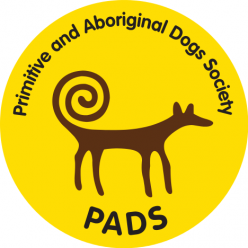Canis familiaris borealis
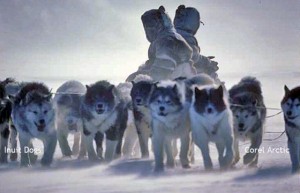
Photo: Corel Arctic
Overview
Like other aboriginal landrace dogs, the Inuit Dog is:
- a class of domestic dogs that emerged as an ecotype within a specific ecological niche;
- largely the result of environmental adaptation, mostly under conditions of natural selection; influenced by human preferences and interference;
- fits the requirement of a specific human society living in a particular ecosystem.
Johan and Edith Gallant1
Although still domestic, Inuit Dogs:
- have evolved by natural selection under conditions of free life and close interactions with people;
- are a unique piece of nature, time bound and place bound, most similar to zoological subspecies;
- are historically associated with ethnic groups and cultures;
- are one of the oldest and most natural…dogs in existence.
Vladimir Beregovoy, PhD2
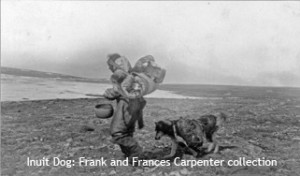
History
The Inuit Dog, considered to be about 4,000 years-old, dates back to the paleoinuit culture and originally accompanied humans across the Bering Strait, eventually migrating with them to Greenland. However, it wasn’t until about 800 BP (Before Present), in the period of the Thule culture, that archaeologists identified sled runners and harness material. Therefore it is believed that in between these two time periods the cultures designated as Independence I, Pre-Dorset, Independence II and Dorset used this aboriginal dog not as a sledge dog but as a hunting partner and defender from polar bears3. One must not assume the Inuit Sled Dog to be just the aboriginal sledge dog of the circumpolar north based on its name alone, for it possesses other essential skills as well. Some of the tasks Inuit dogs perform are: using scent to locate seal breathing holes and birthing lairs, tracking and catching prey wounded by hunters, alerting hunters and family encampments to the presence of bears and then keeping these large predators at bay, carrying belongings on their backs in summer and hauling a heavily laden qamutiq (sledge) over snow and ice covered surfaces. Because of their many capabilities and their legendary resilience to hardships the Inuit Dog is credited as being the principal reason for the survival of the ancestors of today’s modern Inuit4, right up to the mid-twentieth century, at which time the lives of these hunters, already affected by the presence of the outside world, began to dramatically change. Inuit society has transitioned from moving seasonally to hunt and trap, to living in permanent settlements. This conversion accelerated beginning in the 1950s with the introduction of the snowmobile which facilitated a more rapid transit to and from hunting and camping sites for Inuit who began taking part in the wage earning economy and lifestyle.
Appearance, Reproductive Profile and Behavior
There is no written “standard” of appearance for this landrace. The breeding of Inuit Dogs was always focused on stamina and performance, not what they looked like. Lifestyle and harsh polar conditions shaped it for its uses through survival of the fittest and most functional. According to Dr. Vladimir Beregovoy5:
- The individual variation of aboriginal dogs within a single population is much wider than would be allowed in a cultured breed.
- Variation in the appearance of any primitive breed in its authentic condition far exceeds what is considered acceptable in a cultured show breed.
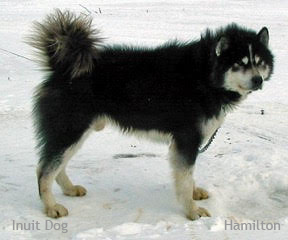
Photo: Hamilton
Despite some variation, there are generalizations that can be made6:
- Considered a hallmark trait, ears unfold earlier than most dogs, at about 3-4 days, become upright, and remain so for life (except ears injured in fights).
- Coat consists of two layers: a thick, insulating undercoat up to 1.5 in (3.8 cm) thick (depending on location), covered by longer, harsher guard hairs which also vary in length depending on location and the dog’s sex. Except for the legs, face, and ears, typical length is 3-5 in. (7.6-12.7 cm). Guard hair is longer on the tail, “bloomers” at the back of the hind legs, and around the neck. The guard hair over the withers is the longest, particularly in the males. The longer hairs in the males’ withers/hackle area is an expression of natural sexual dimorphism (the sexes have different traits). The extra-long hairs make the males look bigger to other males, an advantage when challenging for breeding rights. The longer fur also helps to prevent serious injuries during dominance fights with other males. Guard hairs on the neck and withers may range from 5-8 in. (12.7-20.3 cm) inches in length.
- Coats colors range from all white to nearly all black or dark brown. There are shades of reds and agouti (red mixed with dark brown or black) as well. Except in single colored dogs, the Inuit Dog wears a two-colored coat. Some color patterns are quite uniform, but they don’t have to be. White dogs with brown, red or black heads are not unusual.
- The frequency of expression of the “merqujuq” gene (excessively long and soft guard hair) in the Arctic is low and unpredictable. While not necessarily a sign of impurity, it is considered a serious functional disability and such pups are typically destroyed at birth.
- The eyes can be any shade of amber to brown, but never blue.
- Tails typically curl loosely over the back and then lay against one side of the body. Some tails are less curled and can hang straight when the dog is relaxed.
- The general impression of the overall body style is a robust, sturdily built dog that is not thin or lanky in body, neck or legs. The feet are proportionately large. The skull and muzzle are more “blocky” than fine and the ears are small and nearly triangular.
- Males are reported to be significantly larger in weight, height and broader in body and bone thickness than females. According to Ian Kenneth MacRury in his masters thesis The Inuit Dog: Its Provenance, Environment and History, approximate weights and heights are as follows:
| Male | Female | |
| Weight | 84.9 lbs (38.5 kg) | 67.5 lbs (30.56 kg) |
| Height | 24.3 in (61.7 cm) | 22.4 in (56.9kg) |
In very early times, the dogs were not confined, instead being allowed to roam outpost camps socializing with humans of all ages as well as with their own species. When the dogs were not working in some capacity (not just pulling sledges) for humans they were usually left to forage for their own food. So predatory-aggressive behavior was not only a result of their partnership with a hunting society in the acquisition of animals as food and other raw materials, but also for their own survival when not being fed directly by humans.
Within historically early, free-ranging Inuit Dog society, pack dynamics were established. There existed an alpha dog, also identified as a “king” dog or “boss” dog7. A competent, intelligent boss dog was the one who ruled supremely, generally kept the peace among lower ranking dogs, ate first and most, and was the male who mated with the bitches who could come into estrus twice a year. A good boss seldom fought to injure or kill, unless the lower ranking dog for some reason failed to accept the boss’s authority or decided to challenge it. Where the boss was old and failing, he would be killed by the younger, stronger rival.
Canadian wildlife biologist William Carpenter, co-founder of the Eskimo Dog Recovery Project (early-1970s to mid-1980s) described the Inuit Dog as demonstrating “an exaggerated response to all stimuli.”
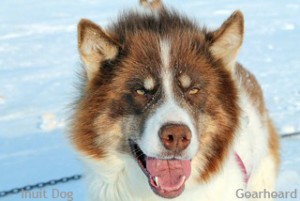
Photo: Gearheard
Threats to Survival and Future
The presence of non-indigenous dogs is now ubiquitous throughout the Canadian North and currently there are no regulatory mechanisms in place to control this influx, either by outright banning or by allowing only altered dogs to accompany their owners north. In Greenland, there is a law forbidding non-indigenous breeds into regions where sled dogs are kept as a measure to keep the Greenland Inuit Dog uncontaminated. However it is believed that strict enforcement has not been in place. For example, after a distemper epidemic around 1986, traditional Inuit Dogs from the north Baffin region of Canada were sent into the Thule District of Greenland. Dogs were also sent into this region from other parts of Greenland as well.
Despite the “Dog Slaughter” carried out by entities of the Canadian Government in the 1950-1970s8 and the current socio-economic challenges that continue to keep the future of the traditional Inuit Dog uncertain, this aboriginal dog endures in regions of arctic Canada and the northern and eastern districts of Greenland. While it is largely gone from Alaska and the western Canadian Arctic in the aboriginal use sense, some Inuit Dogs are present for recreational sledding and tourism. There is some evidence that there may exist (or did exist) Russian “precursors” to Inuit Dogs. Recent genetic results indicate the Inuit Dog is still a pure evolutionary line, separated from other dogs for at least 2,000 years.9
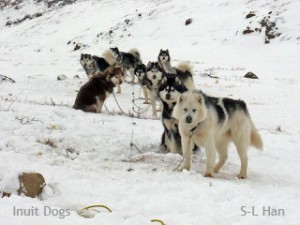
Photo: S-L Han
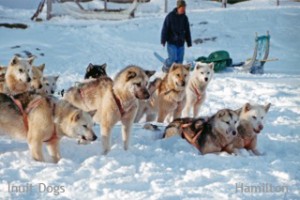
Photo: Hamilton
In May 2000, the year-old government of Nunavut territory, Canada honored the Inuit Dog – not the seal, caribou, musk ox or even the polar bear – as its official territorial animal. The choice recognizes the Inuit Dog, as being uniquely responsible for the survival of the ancestors of today’s Inuit. Without these dogs that were physiologically and anatomically adapted to survive and work at extremely low temperatures, dogs that could perform well even when fed on an irregular basis due to the inevitable periods of starvation imposed by the Inuit’s hunting lifestyle, the northern people could never have mastered the Arctic environment.
Today few Inuit can follow in the footsteps of their Elders and live a traditional lifestyle using dogs. However, many Inuit feel strongly about their culture and, along with a few very dedicated non-Inuit, keep and use these dogs. Thus, traditional Inuit Dogs can still be found in their native habitat, still used for harvesting country food for people and dogs, as well as sport hunting, eco-tourism and expedition travel.
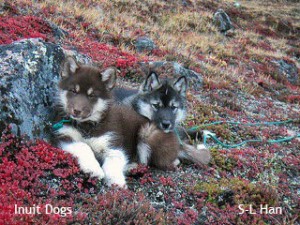
Photo: S-L Han
Text: Sue Hamilton
For more information about the Inuit Dog, please visit The Fan Hitch, Website and Journal of the Inuit Sled Dog, thefanhitch.org
End notes:
1The term “breed”, although often used in referring to primitive aboriginal landraces because that is what most people understand, is not exactly accurate. According to Johan and Edith Gallant, “Breeds are products of breed clubs, not of nature.” Breed, Landrace and Purity: What do they mean?” by Johan and Edith Gallant, The Fan Hitch, V13 N1; December 2010
2The term “primitive” is sometimes disputed as incorrect and belittling of aboriginal dogs. The word “primitive”, in dog context, means natural, functionally justified and undistorted in appearance, behavior and health. Vladimir Beregovoy, PhD., Evolutionary Changes in Domesticated Dogs: The Broken Covenant of the Wild, Parts 1 and 2; The Fan Hitch V11 N2 and 3, March and June 2009
3The Inuit Dog: Its Provenance, Environment and History; Ian Kenneth MacRury; Chapter 1.
4The Inuit Dog: Its Provenance, Environment and History; Ian Kenneth MacRury; pg. 45, para. 1.
5Evolutionary Changes in Domesticated Dogs: The Broken Covenant of the Wild, Part 2;The Fan Hitch, V11 N3, June 2009
6Based on a total of 499 dogs from Canada and Alaska; from The Inuit Dog: Its Provenance, Environment and History by Ian Kenneth MacRury; Featured Inuit Dog Owner: Ken MacRury, The Fan Hitch, V5N4, September 2003; personal communication with Mr. MacRury.
7Boss Dogs and Lead Dogs: Are They Born or Made? by Ken MacRury; The Fan Hitch, V12N1, December 2009
8The RCMP, Qikiqtani Truth Commission and Makivik official reports can be found under “Official reports regarding Canadian Federal Government vis-a-vis Inuit social/cultural issues, including sled dogs” on The Fan Hitch Resources page.
9Brown, S. K., C. M. Darwent, and B. N. Sacks. 2013. Ancient DNA Evidence for Genetic Continuity in Arctic Dogs. Journal of Archaeological Science 40(2): 1279–1288.
